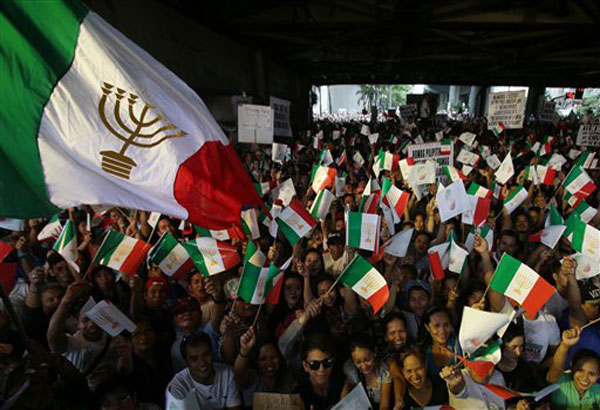The Makati caper and its implications
It started off with a dramatic flourish – Sen. Antonio Trillanes, Brig. Gen. Danilo Lim and their comments on what they were doing.
That set off initially a major alarm over television and radio. And the nation, including us in Negros Occidental, sat back to take in what was happening in the country’s commercial center.
Later, though, I noticed that most of the watchers seemed to have lost their interest in what was going on. The message or messages from the rebellious group did not capture much interest.
I was at the Bylines office where initially the mediamen had their eyes and ears focused on the television. Later, I noticed that most simply went on with their daily chores of editing film shots and putting the finishing touches on news clips.
The Philippines STAR’s Antonieta Lopez, after a flurry of phone calls, simply sat down before her computer and went on working. She only cast glances at the TV. In the nearby Confed office, the staffers went about their work uncaring about what was happening in the country’s commercial center. Several sugar leaders – including Federico Locsin III, chairman of the Negros-Panay chapter; vice chairman Luis Tongoy, and trustees Joe Marie Montinola and Bob Cuenca, just to cite a few – viewed the proceedings with curiosity and went about their meetings.
There was no panic, neither was there enough sympathy for the rebels or adventurists, as they have been called.
Later, in the evening, CNN carried the story of the occupancy of the Manila Peninsula by the adventurists.
But while it landed in the headlines of foreign cable networks, it did not create as much a stir as may have been envisioned by Trillanes and company.
It was the first time in 50 years of the journalistic profession that I saw a blatant disregard of press freedom. DILG Secretary Ronaldo Puno blamed mediamen for sort of obstructing justice by their insistence on staying put despite invitations for them to get out of the second floor of the Manila Pen.
There were a hundred or more mediamen who opted to stay behind. Their purpose: to cover the story closely. They took the risk of possibly losing their lives in the process of coverage. Puno, on the other hand, harped on the fact that the news desks of media establishments had been asked to get their people out of harm’s way – three times. Later, he said, they were already obstructing justice.
Well, Puno may not have realized the fact that the presence of newsmen may have averted what could have been a bloodbath. And one can easily understand that Trillanes himself had realized the effect of the journalists’ presence on the forces ready to launch their assault.
I remember our coverage of the First Quarter Storm and many other similar incidents before Martial Law. Because we wanted to get things right we were often caught in the middle of the fracas between the rioters and government forces. There were many instances when we found ourselves also caught by tear gas fumes. But nobody complained. And the police themselves were often apologetic about the accidental consequences.
Of course, former Vice President Teofisto Guingona and Fr. Robert Reyes had to be taken in tow by the police. But Bishop Julio Labayen, already a doddering old man of 80 years, was forcibly loaded onto a police bus and taken to Camp Bagong Diwa for questioning.
The sickening sight was newsmen and newshens, including prominent personalities, forced to walk from the lobby of the Manila Pen to a holding area. Worse, crewmembers of ABS-CBN were herded and manacled, their equipment forcibly left behind in the elevator.
Nobody seemed to have a command of the situation. The PNP spokesman even went to the extent of insisting that the newsmen should go to Camp Bagong Diwa for processing.
The treatment of mediamen gave rise to suspicions that the killing of journalists and the delayed solution of their murders may actually be part of a state scenario to drive home a point – the suppression of dissent.
That’s why despite the arrest of a suspect in the killing of an Aklan radioman, the one that bothers regional media practitioners is the continued failure of the police to arrest former Lezo mayor F. Asencio charged for the killing of a Bombo Radyo member in Kalibo. Asencio, incidentally, was a former Military Intelligence Group (MIG) member. And he has been reported going around dressed as a woman. Aklan police authorities have admitted receiving the same information.
Never during the Marcos regime were mediamen subjected to such police handling Thursday.
All that could have been done was simple. Magdalo soldiers and the civilian sympathizers could have taken advantage of the confusion and pass themselves off as mediamen. All that could have been done was to identify the leaders of a particular group. After all, mediamen had their identification cards prominently displayed. But to seize their equipment amounted to theft or robbery.
Protestations to the contrary, one cannot escape the suspicion that Thursday’s episode (the first of its kind) indicates a seeming disregard by the government of press freedom.
Even National Press Club president Romy Mabasa vowed that the national association of journalists was taking the cudgels for the harassment of the newsmen. President Arroyo must now clarify the government position on the issue. She cannot take it lying down, especially in the face of a worldwide condemnation of what happened here.
- Latest
- Trending






























